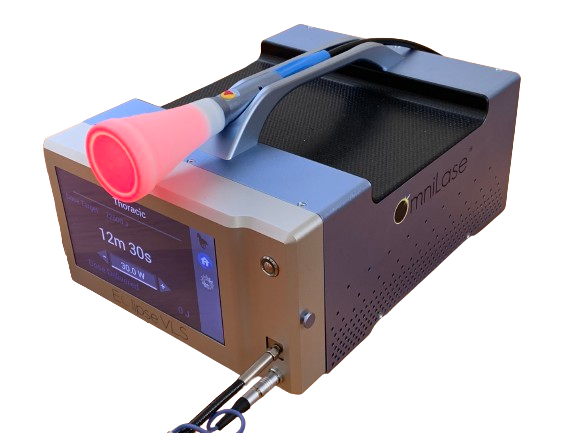Advanced Laser Therapy for Companion Animals
Reaching Deeper — Expanding the Role of Laser Therapy in Small Animal Medicine
Small animals are real frontline soldiers of laser therapy. Light does not penetrate deep under the skin – realistically organs that are located more than 2 inches below the surface cannot be irradiated. Therefore, in human medicine and large animal veterinary, the application of laser therapy is limited to wound healing, pain management, dermatological, and some musculoskeletal conditions. Small animals have lifted this limitation and the entire body can be treated, including abdominal and thoracic cavities. Laser therapy is non-invasive and generally well-tolerated by animals. It does not require sedation or anesthesia, making it suitable for a wide range of patients. Laser therapy is particularly useful for pets with limited medical treatment options, such as:
- Pets with conditions who cannot take medications
- Cats, for whom only a few pain-control medications are approved
- Exotic pets for whom medication administration is difficult or impossible
- Older pets with compromised organ functions
In small animal veterinary practice, laser therapy has become a versatile tool with a huge range of applications. Here are some key aspects of laser therapy in small animal practice:

The OmniLase Advantage: Reaching Where Others Can't
While laser therapy is widely recognized for superficial conditions, OmniLase brings a new dimension to companion animal care. Our systems are engineered to effectively treat the deep-seated issues that truly impact small animal health.
A common misconception is that laser therapy lacks efficacy for deep tissues. OmniLase systems are specifically engineered to overcome this, ensuring therapeutic light reaches internal organs in small animals.
Optimal Wavelength: OmniLase Eclipse models utilize a 1064nm wavelength, which falls within the “optical window” for deep tissue penetration. This specific wavelength has low absorption by superficial chromophores (like melanin and hemoglobin), allowing photons to reach much deeper structures in the small animal body.
High Output Power: Our systems deliver high output power, ensuring a sufficient dose of photons reaches the target internal tissue. This overcomes scattering and absorption losses encountered as light travels through various layers of skin, fat, and muscle.
Large (40mm) Handpiece: Equipped with a large 40mm diameter handpiece, OmniLase systems mitigate the affect of light scattering. This larger spot size allows for more uniform and effective delivery of light to deep-lying organs, unlike smaller diameter handpieces where light is dispersed too quickly to reach sufficient depth.
These combined features ensure that a therapeutic dose of light effectively reaches the intended internal target, enabling true PBM for conditions previously considered inaccessible to laser therapy in small animal patients.
Targeting Internal Health: Underutilized Applications in Small Animals
Beyond common musculoskeletal applications, OmniLase unlocks new therapeutic avenues for critical internal conditions in cats and small dogs, where their smaller dimensions allow for effective deep penetration.
Inflammatory Bowel Disease (IBD)
For IBD, deep-penetrating PBM therapy targets gut inflammation directly, helps balance gut microbiota, and improves nutrient absorption. It is particularly useful for chronic vomiting and diarrhea cases, especially in cats, where reaching the inflamed bowel wall is crucial.
By effectively reducing inflammation deep within the intestinal layers, PBM can significantly improve clinical signs and reduce the frequency of gastrointestinal upsets, offering a valuable adjunctive therapy.
Chronic Kidney Disease (CKD)
As a supportive modality for CKD, deep-penetrating PBM aims to improve renal function, slow disease progression, and enhance quality of life by decreasing kidney inflammation and potentially activating stem cells. Its non-invasive nature is ideal for compromised patients.
Pancreatitis
In this painful condition, OmniLase’s deep-penetrating PBM helps by directly targeting inflammation within the pancreas, increasing local circulation, reducing swelling, and promoting tissue regeneration. Its ability to reach this deep organ is key.
A significant benefit is pain relief through endorphin stimulation and reduced nerve sensitivity at the source of the inflammation. It’s a promising addition to comprehensive management plans for mitigating acute inflammatory crises.
Post-Surgical Abdominal Recovery
An underutilized application, deep-penetrating PBM significantly enhances recovery following internal abdominal surgeries (e.g., spays, neuters, exploratory laparotomies). It accelerates healing of deeper incision layers and internal organ tissues, reduces inflammation, and manages post-operative pain at the surgical site.
By targeting the internal surgical field, it minimizes complications and speeds up the overall recovery process for small animals, reducing the need for extensive pain medication.
Chronic Cystitis / Feline Lower Urinary Tract Disease (FLUTD)
For chronic and painful bladder inflammation (cystitis, common in FLUTD cases), OmniLase PBM delivers light deep enough to reach the bladder wall. This helps reduce inflammation, soothe irritation, and promote healing of the urothelium.
It provides a non-pharmacological option for managing discomfort and recurrence, especially beneficial for cats prone to idiopathic cystitis.
Chronic Rhinitis / Nasal Inflammation
In cases of chronic nasal inflammation and rhinitis, particularly challenging in small brachycephalic breeds, deep-penetrating PBM can reach inflamed turbinates and nasal passages. It reduces inflammation, aids in clearing mucus, and can alleviate chronic discomfort.
This therapy offers a way to manage difficult, recurrent upper respiratory issues that are often unresponsive to conventional topical or systemic treatments alone.
Neurological Conditions
PBM shows significant potential in treating CNS injury, peripheral nerve injury, and neurodegeneration in small animals. The 1064nm wavelength is ideal for penetrating neural structures, supporting nerve regeneration, boosting mitochondrial function in neurons, and inhibiting neuroinflammation.
It is often used in combination with other therapeutic approaches to improve recovery, particularly for spinal injuries or nerve damage, enhancing the quality of life for affected pets.


